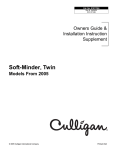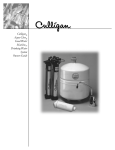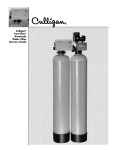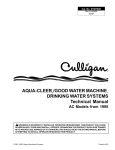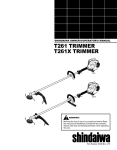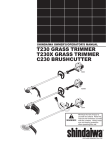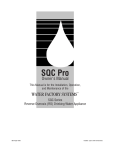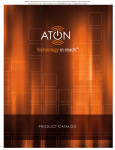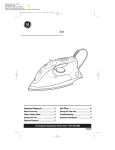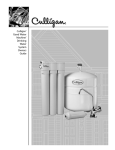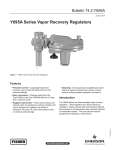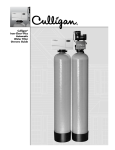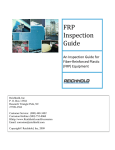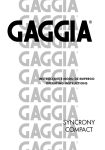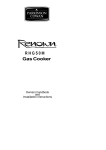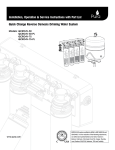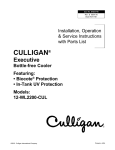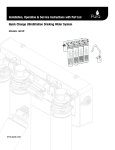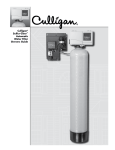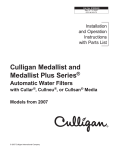Download Culligan H30 Specifications
Transcript
Cat. No. 01018587 Rev. F 02/15/12 DCO # 013023 Technical Manual Aqua-Cleer® / Good Water Machine® Drinking Water Systems Models from 2005 © 2007 Culligan International Company Attention Culligan Customer: Your local independently operated Culligan dealer employs trained service and maintenance personnel who are experienced in the installation, function and repair of Culligan equipment. This publication is written specifically for the purpose of training and guiding these individuals and is intended for their use. We encourage Culligan users to learn about Culligan products, but we believe that product knowledge is best obtained by consulting with your Culligan dealer. Untrained individuals who use this manual assume the risk of any resulting property damage or personal injury. These systems are intended for use on potable water supplies or disinfected water containing cysts. Do not use where water is microbiologically unsafe or with water of unknown quality. If bacterial contamination is present, a recognized method of water disinfection is required. Check with your public works department for applicable local plumbing and sanitation codes. Follow your local codes if they differ from the standards used in this manual. For installations in Massachusetts, Massachusetts Plumbing Code 248 CMR shall be adhered to. Consult your licensed plumber for installation of this system. The use of piercing valves is not permitted in Massachusetts. The Aqua-Cleer® system contains a replaceable reverse osmosis membrane filter which is critical for the effective reduction of Total Dissolved Solids. The filtered water should be tested periodically to verify that the system is performing properly. Safe Practices Throughout this manual there are paragraphs set off by special headings. Notice: Notice is used to emphasize installation, operation or maintenance information which is important, but does not present any hazard. Example: NOTICE: The nipple must extend no more than 1 inch above the cover plate. CAUTION: Caution is used when failure to follow directions could result in damage to equipment or property. Example: CAUTION! Disassembly while under water pressure can result in flooding. WARNING: Warning is used to indicate a hazard which could cause injury or death if ignored. Example: WARNING! Electrical shock hazard! Unplug the unit before removing the timer mechanism or cover plates! Serial Numbers The serial number is located on the rear of the R.O. module housing. NOTICE: Do not remove or destroy the serial number. It must be referenced on requests for warranty repair or replacement. This publication is based on information available when approved for printing. Continuing design refinement could cause changes that may not be included in this publication. CULLIGAN INTERNATIONAL COMPANY 9399 W. Higgins Road, Suite 1100 Rosemont, Illinois USA 60018 847/430-2800 www.culligan.com WARNING! If incorrectly installed, operated or maintained, this product can cause severe injury. Those who install, operate, or maintain this product should be trained in its proper use, warned of its dangers, and should read the entire manual before attempting to install, operate or maintain this product. i Aqua-Cleer® / Good Water Machine® Technical Manual Aqua-Cleer® / Good Water Machine® Drinking Water Systems Models from 2005 Table of Contents Page Specifications . . . . . . . . . . . . . . . . . . . . . . . . . . . . . . . . . . . . . . . . 2 Suggested Installation Equipment . . . . . . . . . . . . . . . . . . . . . . . . 3 Product Information . . . . . . . . . . . . . . . . . . . . . . . . . . . . . . . . . . . 4 Component Description . . . . . . . . . . . . . . . . . . . . . . . . . . . . . . . . 5 Part Numbers . . . . . . . . . . . . . . . . . . . . . . . . . . . . . . . . . . . . . . . . 6 In-Plant Preparation . . . . . . . . . . . . . . . . . . . . . . . . . . . . . . . . . . . 7 Installation . . . . . . . . . . . . . . . . . . . . . . . . . . . . . . . . . . . . . . . . . .11 Performance and Technical Information . . . . . . . . . . . . . . . . . . .19 Service and Maintenance. . . . . . . . . . . . . . . . . . . . . . . . . . . . . . .27 Troubleshooting . . . . . . . . . . . . . . . . . . . . . . . . . . . . . . . . . . . . . .30 Table of Contents 1 Specifications System Flow Sequence . . . . . . . . . Particle Filter, Activated Carbon Filter, Reverse Osmosis Membrane, Storage Tank, Polishing Filter, Dispensing Faucet Particle Filter. . . . . . .. . . . . . . . . . . 5 Micron or 1 Micron Spun Polypropylene Activated Carbon Filter. . . . . . . . . . Cullar® G Activated Carbon or 5 Micron Activated Carbon Block Reverse Osmosis Membrane. . . . . Culligan® Aqua-Cleer® Thin Film Composite Production Rate1 - . . . . . . . . . . . . . AC-15 Models 15 gpd (57 L/day) - Model no longer available . . . . . . . . . . . . . . . . . . . . . . . . . . . . AC-30 Models 30 gpd (119 L/day) . . . . . . . . . . . . . . . . . . . . . . . . . . . . AC-50 Models 50 gpd (189 L/day) Ratio of Product to Flush Flow2 . . . . . . . . . . . . . . . . . . . . . . . . . . . . Soft Water Applications 2:33 (AC-15 & AC-30 models only) . . . . . . . . . . . . . . . . . . . . . . . . . . . . Hard Water Applications 1:3 - 1:5 Polishing Filter . . . . . . . . . . . . . . . . Cullar G Activated Carbon or Carbon Block Dispensing Faucet . . . . . . . . . . . . . Culligan Aqua-Cleer Faucet: Rotary Operation, Stainless Steel and Resin Flow Passages, with Built-in Siphon Break . . . . . . . . . . . . . . . . . . . . . . . . . . . . Colors Polished Chrome, White Storage Capacity . . . . . . . . . . . . . . . . . . . . . . . . . . . . Standard Tank 2 gallons (7.5 L) . . . . . . . . . . . . . . . . . . . . . . . . . . . . Medium Tank 3 gallons (10.5 L) . . . . . . . . . . . . . . . . . . . . . . . . . . . . Large Tank 9 gallons (34 L) Dimensions . . . . . . . . . . . . . . . . . . . . . . . . . . . . Filter Assembly 7.5”W x 3”D x 16.5”H (20 cm W x 8 cm D x 42 cm H) . . . . . . . . . . . . . . . . . . . . . . . . . . . . Storage Tank • Std. 9” Diameter x 15”H (23 cm Diameter x 38 cm H) • Med. 11” Diameter x 15”H (28 cm Diameter x 38 cm H) • Lrg. 15.5” Diameter x 22”H (40 cm Diameter x 56 cm H) 1 Rating at 50 psi, 77°F, 500 mg/L TDS influent, without storage tank. 2 May vary with pressure. See “Adjust Capillary Length”, page 8, for all hard water applications and applications where TDS exceeds 1000 mg/L (ppm). 2 Aqua-Cleer® / Good Water Machine® Suggested Installation Equipment Sink Cutting Tools Porcelain Cutter Kit, 1-1/4 inch diameter, PN 00591625 Greenlee Hole Punch, 1-1/4 inch diameter Plumbers Putty Heavy Duty Drill with speed control to 400 rpm Tools Screwdriver, blade and Phillips (#1) 1/8 inch diameter pilot drill for #10 screws Center Punch Razor Blade Knife Faucet Installation Tool, PN 00403375 Aqua-Cleer® H Series or “System” series filter housing, PN 00402985 Accessories/Hardware Tubing, Plastic, 1/4-inch, PN 00402184 Blue Tubing, Plastic, 3/8-inch, PN 01000287 Blue Piercing Valve, PN 00571402 Drain Saddle Kit, PN 42000001 Silicone Lubricant, PN 00471507 Thread Sealing Tape TDS Meter, PN D0470504 Graduated Measuring Cylinder, PN 00470503 Thermometer, PN 00470501 Stopwatch, or wristwatch with second hand Chlorine Bleach (Clorox* unscented household, 5-1/4% strength) Eye dropper (available at drug store) Pressure Gauge (0-120 psi) with section of 1/4” OD tubing connector #10 Screws, type determined by mounting surface and material Tee, PN 01004728, if system will be connected to icemaker Miscellaneous Extension Work Light Air Pressure Gauge Air Pump (bicycle tire pump) Furniture pad for Back Protection Small Portable Blower for Ventilation *Clorox is a registered trademark of the Clorox Company. Suggested Installation Equipment 3 Product Information This manual covers the technical aspects of Culligan® Aqua-Cleer® Good Water Machine® AC model drinking water systems. It is important to read this manual thoroughly so that you can properly apply, install, and service these systems. The Culligan Good Water Machine models AC-30, AC-3M, AC-30C, AC-30 Plus, AC-30M Plus, and AC-30L Plus have been tested and certified by WQA against NSF/ANSI 372, CSA B483.1, and NSF/ANSI Standard 58 for the effective reduction of TDS, Barium, Cadmium, Hexavalent, and Trivalent Chromium, Lead, Radium 226/228, Copper, and Selenium as verified and substantiated by test data. The substances removed by this system are not necessarily in the customer’s untreated water. See Performance Data Sheet (located in the Owners Guide) for exact percentages of contaminant removal. Carton 1: Carton 2: Carton 3: Carton 4 (Platinum Units): Filtration Assembly Storage Tank Faucet Aqua-Cleer Sentry® Monitor Reverse Osmosis Membrane Element Particle Filter Element Activated Carbon Filter Element Polishing Filter w/Mounting Pad Parts Package, including: Tank Valve Mounting Bracket Product Literature Notice: The filter elements are shipped in their own sealed packaging. This will help to simplify in-plant preparation of the system and to maximize the shelf life of the RO membrane element. If the Aqua-Cleer system will not be installed immediately, refrigerate the RO membrane element at 35°/40°F (2°/5°C). DO NOT ALLOW TO FREEZE. Influent Water Characteristic Pressure 40 - 120 psi Temperature 33 - 100 ºF Total Dissolved Solids (TDS) pH 1 0 - 2500 ppm (0 - 2500 mg/L) 5 - 10 Chlorine 2 0 - 3 ppm (0 - 3 mg/L) Chloramine 0 - 3 ppm (0 - 3 mg/L) Packaging Turbidity 0 - 10 NTU The Aqua-Cleer system is shipped from the factory in three cartons for standard units and four cartons for Platinum units: Hardness3 0 - 10 gpm Iron 0 - 1 ppm (0 - 1 mg/L) Bacterial Quality Potable Warranty A limited warranty is extended to the original end user from Culligan. This warranty is printed on the back cover of the Owner’s Guide. Notes 1. See the “Performance & Technical Information” section for all applications where TDS exceeds 1000 ppm. A booster is strongly recommended to improve the reduction of TDS. Higher pressures will help maintain the membrane’s maximum rejection performance. 2. The reverse osmosis membrane used in these systems may be damaged by chlorine. These systems include activated carbon filters which protect the membranes by reducing chlorine. Influent chlorine should not exceed 3 mg/L. 3. A softener is strongly recommended for water over 10 gpg hard. Installing a system without a softener on water with hardness higher than 10 gpg will reduce the life of the membrane. 4. Additional information on factors that affect RO performance can be found in the “Performance & Technical Information” section. Application Guidelines The Aqua-Cleer/Good Water Machine system is designed for use on potable water supplies meeting the guidelines outlined in Table 1. The system should be installed on a home’s cold water line. The flushing stream should discharge through an approved siphon break. Installation of this system must comply with state and local laws and regulations. Table 1 High Efficiency Operation The Aqua-Cleer system is designed for high-efficiency operation. Soft water use is strongly recommended. For maximum RO membrane life on all hard-water installations, adjust the capillary length as described in the “In-Plant Preparation” section of this manual. (Not required for LC-50) 4 Aqua-Cleer® / Good Water Machine® Component Description Tubing Connectors The Aqua-Cleer®/Good Water Machine® system features reliable and convenient push-to-connect (Figure 1) tubing connectors. Tubing is easily connected and disconnected from these fittings as follows. Connect: Cut the tubing squarely with a sharp knife. Be careful not to crush the tubing. To avoid leaks, make sure the tubing end is smooth and free of burrs and abrasions. Lubricate the end of the tube with water or a light coat of silicone and push the tube end firmly into the fitting. You should feel it push past the O-ring. Avoid bending the tubing sharply away from the fitting. Disconnect: Hold the collar against the fitting body and pull the tube from the fitting. In the unlikely event that the connection leaks, remove and recut the tubing. Check the inside of the fitting for debris or O-ring damage. Reconnect. Push-to-connect tubing connectors grip the outside diameter of the tube. To help assure a reliable connection, it is important to use high quality tubing with a consistent outside diameter. Culligan recommends that the tubing listed in the “Suggested Installation Equipment” section of this manual (page 5) be used with the Aqua-Cleer/Good Water Machine system. QUICK-CONNECT FITTING Insertion & Removal of Plastic or Copper Tubing 1. Simply push in tube to attach. 2. Tube is secured in position. 3. Push in collet from both sides to release tubing. Figure 1 Manifold/Main Filter Assembly • Manifold Assembly The manifold assembly, Figure 2 item (1), serves as the functional hub of the Aqua-Cleer/Good Water Machine system by directing the flow through each of the system’s main components. • Particle Filter The particle filter (2) is wound from spun polypropylene cord and is closed at one end. The particle filter screens out particulate material, such as dirt, sand, or rust, which may clog the other filters in the system. The filter is available in either 5 microns or 1 micron. • Activated Carbon Filter The activated carbon filter (3) is offered in two styles, granular or block. Both are rated to treat 2000 gallons of water containing 2.0 ppm of chlorine. The active material is acid washed activated carbon. The activated carbon filter reduces chlorine which may damage the RO membrane filter. It must be regularly checked and or replaced to prevent premature membrane failure. Component Description 5 13 6 7 11 4 3 5 2 17 15 16 10 12 8 9 8 Figure 2 Item Description 1 AC Manifold 2 Sediment Filter (5 Microns, 10/pack) Sediment Filter (1 Microns) 3 Carbon Filter (Block, 12/pack) Carbon Filter (Block, 50/pack) Carbon Filter (GAC, 10/pack) 4 Membrane (30GPD, 10/pack) Membrane (30GPD, 50/pack) 5 Capillary Assembly 6 Automatic Shutoff Valve 7 Drain Adapter (10/pack) 8 Housing (Filter) x2 9 Housing (Membrane) 10 Clip (10/pack) 11 Screw (25/pack) 12 Mounting Bracket 13 Chrome Faucet White Faucet Chrome Faucet w/ Light White Faucet w/ Light * Monitor (* Not Shown) 15 Post Filter 3/8” Block (10/pack) Post Filter 3/8” Block (50/pack) Post Filter 3/8” GAC (10/pack) Post Filter 3/8” GAC (50/pack) 16 Storage Tank - 2 Gallon Storage Tank - 3 Gallon Storage Tank - 9 Gallon 17 Ball Valve Part No. 01-0047-02 01-0001-20 01-0056-72 P1-0125-80 01-0126-00 01-0001-21 01-0074-09 01-0074-08 01-0090-25 01-0044-31 P1-0042-92 01-0044-30 01-0044-29 P1-0055-37 P0-4010-16 01-0040-81 01-0184-01 01-0184-02 01-0184-68 01-0184-69 01-0196-19 01-0146-12 01-0146-13 P1-0042-91 01-0047-68 01-0050-95 01-0047-76 01-0047-65 01-0045-50 • Reverse Osmosis Membrane The RO membrane (4) reduces dissolved substances and other microscopic impurities such as asbestos, lead, sodium, and others. It consists of a membrane envelope wound around a perforated tube. Product water diffuses through the membrane to the inside of the envelope where it flows to and is collected by the tube. Impurities are flushed away in the concentrate stream. The RO membrane featured in the Aqua-Cleer®/Good Water Machine® system offers exceptional contaminant rejection, application versatility, and long life. The membrane material is sensitive to attack by chlorine. The activated carbon filter must be maintained properly to prevent premature failure of the RO membrane. The RO membrane (4), MAY be shipped wet in a preservative solution. This solution is present to prevent microbiological growth inside the membrane. It must not be allowed to dry out or freeze as damage will likely result. Culligan may ship both wet and dry elements depending on inventory. Wet elements are the result of batch quality testing and are no different than dry elements. The outer packaging of wet elements will clearly state that the units contain a preservative solution. NOTE: This preservative must be flushed from membrane before use. If ingested it may cause irritation of the gastrointestinal tract, colic, diarrhea, or other similar symptoms. The manufacturer recommends discarding all the product water for at least one hour of operation before drinking or use in food preparations. Culligan highly recommends discarding the product water for a full 24 hours to flush the preservative and to properly hydrate the membrane for maximum performance. The flushing procedure is on page 9. • Capillary Assembly The capillary assembly or concentrate flow control (5) regulates the flow rate of the flushing (concentrate) stream and to maintain pressure in the RO membrane filter. It is located in the end of the manifold assembly. The assembly can be adjusted to change the rate of the concentrate stream. The adjustment procedure is on page 8. NOTE: Changing the capillary length voids the WQA listing. Remove the WQA data label from the system if you adjust the capillary length. • Automatic Shutoff The automatic shutoff (6) automatically stops the flow of water through the Aqua-Cleer/Good Water Machine system when the storage tank is full. 6 Aqua-Cleer® / Good Water Machine® In-Plant Preparation Storage Tank The storage tank (16) collects and stores the water produced by the Aqua-Cleer/Good Water Machine system. A compressed air diaphragm drives the water to the polishing filter and faucet. The ball valve (17) provides a convenient way to lock water in the tank during transport and filter changes. Polishing Filter The polishing filter (15) adsorbs any residual tastes and odors just before the water is delivered through the faucet. Aqua-Cleer Sentry™ Monitor This optional monitor (14) accessory (standard on Premier™ models) checks the TDS level of the drinking water each time the dispenser faucet is used. A green LED indicator (Figure 3) mounted in the faucet signals if the TDS level is below the setpoint, an red signal appears if it is above. Dispenser Faucet The Aqua-Cleer faucet (13) allows the product water to be drawn from the system with a simple rotation of the handle. It features a built-in siphon break for concentrate discharge as required by most plumbing codes. To help assure quick and trouble-free installation of the Aqua-Cleer® system, the following preparation steps should be performed in the dealer facility. Cleanliness is essential in the In-Plant Preparation procedure. Be sure to wash your hands thoroughly before handling filters. The use of surgical gloves is strongly recommended. Figure 3 Filter Assembly Preparation Pre-Filter 1. Install the prefilter into the service housing. 2. Connect the inlet of the service housing to a source of clean, filtered water. 3. Connect the outlet of the service housing to a suitable drain. 4. Slowly turn on the water and flush the filter for 10 minutes. 5. Remove the pre-filter cartridge from the service housing and set it aside in a clean location for installation into the Aqua-Cleer system. Activated Carbon Filter The activated carbon filter must be thoroughly flushed to remove carbon dust which can plug the manifold or RO membrane. To perform this procedure, it is necessary to use a clean, spare Aqua-Cleer H-83 (or H-82, 52, 53) series or “System” series filter housing (Figure 4) as a service housing. 1. Install the activated carbon cartridge into the service housing. 2. Connect the outlet of the service housing to a source of clean, filtered water. 3. Connect the inlet of the service housing to a suitable drain. 4. Slowly turn on the water and back-flush the filter for 10 minutes at a rate of 1-2 gpm (4-7 L/min). Turn the water on and off several times during flushing to help loosen carbon particles from the filter. Figure 4 5. Reverse the connections and forward flush the filter briefly until the water runs clear. 6. Remove the activated carbon filter cartridge from the service housing and set it aside in a clean location for installation into the Aqua-Cleer system. In-Plant Preparation 7 • Sanitize Filter Assembly The Aqua-Cleer system may be sanitized with either 5-1/4% liquid chlorine unscented bleach or a fresh bottle of consumer grade hydrogen peroxide. NOTICE: Do not use hydrogen peroxide if iron is present in the raw water supply. This combination will damage the RO membrane filter. 1. Pull the u-clip from the rear of the particle filter housing and remove housing from manifold. For Older Units: Insert the u-clip into the two square holes at the bottom rear of the manifold. Push up to release the filter housing. 2. Pour: two tablespoons liquid chlorine bleach or 3 ounces hydrogen peroxide into the particle filter-housing. 3. Assemble the housing to the manifold and replace the u-clip. 4. Using 1/4” OD plastic tubing, connect the inlet of the system (raw water) (Figure 5) to a source of clean filtered water. 5. Install short lengths (2-3”) of 1/4” OD and 3/8” OD plastic tubing into the concentrate and product water outlets. 6. Turn on the supply valve and allow the system to fill with water. Once water begins to drip or flow from the filter assembly, turn off the supply valve and allow the system to sit for ten minutes. 7. Turn on the supply valve and flush the sanitizing solution from the system. Figure 5 • Install Filter Cartridges 1. Pull the u-clip from the rear of the particle filter housing and remove housing from manifold. For Older Units: Insert the u-clip into the two square holes at the bottom rear of the manifold. Push up to release the filter housing. 2. Lubricate the cartridge o-ring with silicone lube and insert the particle filter cartridge into the manifold. 3. Assemble the housing to the manifold and replace the u-clip. 4. Repeat steps 1-3 and install the flushed activated carbon filter cartridge into housing and the RO membrane filter element into the center housing. Be sure the drain adapter is in place. • Adjust Capillary Length The Aqua-Cleer®/Good Water Machine® system is designed for maximum efficiency on most soft water installations. On hard water installations and applications where TDS exceeds 500 mg/L (ppm), it is necessary to increase the flushing water flow to maximize RO membrane life. This is done by shortening the length of the capillary tube (Figure 6) in the concentrate flow control. Figure 6 If the system is to be installed on hard water or where TDS exceeds 500 mg/L (ppm), proceed as follows: 1. Loosen the capillary retaining screws 1/4 - 1/2 turn. 2. Rotate the capillary assembly free of the retaining screws and pry it from the manifold. 3. Remove the white capillary retaining sleeve and unroll the capillary tube from the spool. 4. For systems on water with hardness higher than 10 gpg and TDS between 500 and 1000 mg/L cut the capillary tube squarely in half with a new razor blade, being careful not to crimp the end. 5. For systems on water with TDS higher than 1000 mg/L cut the capillary tube squarely down to 2 inches with a new razor blade, being careful not to crimp the end. 6. Replace the capillary sleeve and rewind the capillary tubing onto the spool. 7. Reinstall the capillary assembly into the manifold and retighten the retaining screws. NOTE: Changing the capillary length voids the WQA listing. Remove the WQA data label from the system if you adjust the capillary length. 8 Aqua-Cleer® / Good Water Machine® • Flush RO Membrane The RO membrane must be flushed prior to use. 1. Turn on the supply valve to the system. 2. Allow the product water and flushing water to flow to a suitable drain for 24 hours. • Check Performance Check the performance of the system according to the procedure beginning on page 20 of this manual. Storage Tank Preparation • Check Air Pressure Using a tire gauge with 1 psi increments, check the air pressure in the empty storage tank. The air pressure should be between 5 and 15 psi, for the 2, 3 and 9 gallon storage tanks. Depending on the influent water pressure the air pressure may need to be adjusted. Refer to page 25 to determine the optimal air pressure setting. To modify the air pressure use a bicycletype hand pump to increase the air pressure or depress the stem of the air valve to decrease the pressure. NOTE: Changing the air pressure will alter the amount of water stored in the tank. Increasing the pressure will decrease capacity while decreasing pressure will increase capacity. • Install Tank shut-off valve Use a high quality, food-grade thread sealant or PTFE tape to assemble the valve onto the tank.To avoid future leaks, do not over tighten the plastic valve onto the tank. • Sanitize the Storage Tank The reservoir must be flushed and sanitized prior to installation as follows: 1. Connect a length of 3/8” OD plastic tubing to the tank valve. 2. With an eyedropper or similar device, inject 1 tablespoon of Hydrogen Peroxide or 1 teaspoon of 5-1/4% liquid unscented chlorine bleach into the tube. 3. Connect the tubing to a source of clean, filtered water (RO or DI water, if available) at no more than 40 psi. 4. Turn on the water supply, open the tank valve, and allow the tank to fill. 5. Turn off the water supply, close the tank valve, and allow the tank to sit ten minutes. 6. Disconnect the tubing from the supply, open the tank valve, and drain the storage tank. 7. The water coming from the storage tank should have a chlorine odor. If not, repeat steps 2-6 until it does. 8. Fill and empty the tank (steps 3,4,6) until only a faint chlorine odor remains. The polishing filter will remove any residual chlorine taste once the system is installed. • Fill the Storage Tank (optional) So that your customers can begin using their new Aqua-Cleer®/Good Water Machine® system immediately upon installation, you may wish to fill the storage tank with RO product water. Once the in-plant preparation of the Filter Assembly (prior section) is complete, proceed as follows: 1. Connect a length of 3/8” OD plastic tubing between the tank ball valve and the product water fitting (figure 5) on the manifold. 2. Insert a 3/8” OD tubing plug into the faucet product water fitting on the manifold. 3. Using 1/4” OD plastic tubing, connect the system inlet to a water source meeting the characteristics listed in Table 1. 4. Using 1/4” OD plastic tubing, connect the concentrate outlet to a suitable drain. 5. Turn on the water supply, open the tank ball valve, and allow the tank to fill (3-4 hours). 6. Once the tank is full, close the tank ball valve and disconnect the system so that it can be transported to the installation site. WARNING! Do not use the tank ball valve to lift or carry the tank. In-Plant Preparation 9 Faucet Preparation The Aqua-Cleer/Good Water Machine faucet may be assembled prior to installation in the customer’s home. Refer to the faucet installation section beginning on page 15 for details. Polishing Filter Preparation The polishing filter must be flushed prior to use to remove any carbon dust generated during shipment. 1. Using 3/8” OD plastic tubing, connect the inlet of the filter to a source of clean filtered water (RO or DI water, if available). Observe the direction of flow arrow on the filter. 2. Turn on the water supply and flush the filter with at least 2 gallons of water. 3. Turn off the water supply, disconnect the filter, and set aside for final installation. 10 Aqua-Cleer® / Good Water Machine® Installation The exact placement of the components will vary by installation. Although shown beneath a sink, it may be installed in a basement, crawl space, or in an adjacent cabinet. Regardless of where the system is installed, the flow sequence described by (Figure 7) must be observed. The Aqua-Cleer®/Good Water Machine® drinking water system is designed to be mounted near a sink for easy access to cold water and drain lines. Lengths of 1/4-inch and 3/8-inch OD plastic tubing will be required to make this installation. A length of Culligan® drain tubing is required to install the air gap siphon break. Evaluate the installation site to determine the easiest path for the plumbing to follow. Take care to make the installation as neat as possible. Aqua-Cleer Faucet Monitor Sensor Drain Tubing From Faucet Air Gap - 3/8” Tubing Cold Water Supply Monitor Feed Line 1/4" Tubing Post Filter 3/8" Tubing to Faucet Product Port 1/4" Tubing to Faucet Air Gap AC-30 Manifold Ball Valve 3/8" Tubing to Faucet Product Port Tank Figure 7 NOTICE: Install the drain line so that it runs downward with no loops or low spots. Otherwise the unit will overflow at the air gap siphon break built into the faucet, or make irritating gurgling sounds. The concentrate line that leads to the faucet should be installed in a straight vertical path to avoid making a gurgling noise. Installation 11 The following steps will enable you to install the system quickly and orderly. Some variation may be necessary depending on the installation. See page 5 for a check list of tools and materials. The flat-bottom design of the filter housings allows the option of standing the filter system assembly on the cabinet floor rather than mounting it to the wall. The filter assembly is reversible on the mounting bracket. Typical installations follow this sequence: • Select Component Installation Locations. • Clear and Prepare Area. • Install Faucet. • Provide Inlet Water Supply. • Provide Drain Connection • Install Reservoir Tank. • Install Filter System Assembly. • Connect All System Components. • Start-Up • Performance Check • Clean up Work Area. • Review Operation with Customer. Select Component Installation Locations • Dispenser Faucet - The Culligan® faucet is designed to be mounted on the rear lip of the sink. It may be installed in an existing sprayer attachment hole or in a hole drilled at the time of installation. It may also be mounted to an adjacent counter top. It should be positioned so that water is dispensed over the sink. A minimum 1-1/4” diameter hole is required. When installing the Aqua-Cleer Sentry™ water quality monitor, refer to the installation instructions packaged with the monitor. Make certain the TDS level setting corresponds to the customer’s water supply. • Important considerations: • Access to the bottom (undersink) of the faucet is required for attachment of product water line. • The faucet can be installed for left- or right-handed operation. • There should be no undersink obstructions which would prevent smooth tubing runs to the drain connection, carbon postfilter, or RO module assembly. • Filter System Assembly - The filter system assembly is designed to be mounted on any rigid vertical surface such as a cabinet sidewall or basement rafter. It should be positioned such that there is access to an inlet water source and drain. The installation should also allow convenient access for servicing. • Inlet Water Supply Connection - Once a location is chosen for installation of the filter system assembly, select a nearby cold water line to provide the water source for the system. For undersink installations, the cold water faucet line can usually be tapped. NOTE: Follow all local plumbing codes when connecting to service water. 12 Aqua-Cleer® / Good Water Machine® • The Reservoir Tank - Position the reservoir tank near the faucet for optimum customer convenience. The standard & medium reservoir tank will weigh about 28 pounds (13 kg) when full of water, so it must be positioned on a stand or held securely by the optional mounting bracket, PN 01016259 (Figure 8). The reservoir operates best in the vertical position, but it will operate on its side. However, air will not escape readily and foaming may occur at the faucet nozzle. This should be explained to the customer prior to installation. • Drain Connection - The most convenient entry to the drain is directly above the P-trap of the kitchen sink. However, the concentrate water from the system can be connected to adjacent sinks or a floor drain. Extra care should be taken when entering drains near dishwashers or garbage disposals as back flow may occur through the air gap and cause flooding. NOTE: Follow all local plumbing codes when connecting to service water. Figure 8 Clear and Prepare Area Since this product is more likely to be installed within the customer’s daily living space than other water conditioning products, the installation area should be kept neat and clean. If possible, consult with the customer as to how the installation site is used. Faucet Installation The Aqua-Cleer®/Good Water Machine® drinking water faucet was designed by Culligan to compliment the RO drinking water system. Properly installed, it will help to maximize your customer’s product satisfaction. To simplify its access and installation, we suggest you install the faucet on the rear lip of the sink. It should be evenly positioned with the sink faucet and spray attachment. Should the spray faucet hole not be available for the installation, the sink must be drilled. Sink Drilling Instructions Spout Spout Tip Nut Nut Clip Washer Handle Spout O-ring 2 Pcs Spring Inner Body Screw Handle Cap Housing Monitor Flow Sensor Air Gap Quick Connect Cartridge Housing O-ring Base Screw Monitor Air Gap O-ring 2 Pcs. Washer Butterfly Nut Figure 9 Installation 13 Stainless Steel Sink • Select the proper faucet location. • Center punch hole to provide a starting point for your drill. • Drill a 1/2-inch hole to accept the shank of a 1-1/4-inch Greenlee Hole Punch. • Insert the punch. Cut the hole by tightening the drive screw. • Remove any roughness with a file and clean up metal chips. Porcelain Enamel Sink Follow these basic guidelines when drilling a porcelain sink: • Penetrate the porcelain to the base material. • Protect the surrounding porcelain material • Use the appropriate tool to drill the base material. One proven tool is the Relton porcelain cutter kit, PN 00-5916-25, when used with a slow speed drill (300-400 rpm). • Drill a pilot hole through the porcelain and base material with the carbide tip drill. • Build a putty dam around the drill area. Add enough water to lubricate cutters and reduce cutting noise. • Insert the porcelain cutter into the drill. • Place the drill tip in the pilot hole. Check for free movement. • Apply light pressure to the cutter tool and start the drill motor at low speed (300-400 rpm). When the initial cut has been made in the porcelain, speed may be increased. After a complete ring has been cut through the porcelain, change over to the metal cutter. • Avoid contacting the outer rim of cut porcelain when drilling. CAUTION! Avoid high drill speed during penetration of porcelain. A single speed drill can be used at a slow speed by switching it on and off quickly. • Use a slow speed and light pressure to cut away the porcelain. • Stop when you reach the metal under the porcelain. Remove the cutter and clean the porcelain chips from the surface. Continue cutting through the metal. NOTICE: Ceramic tile counters should be treated like porcelain when penetrating the surface, then treated as metal to complete the hole with carbide drills. Formica countertops can be drilled with a high-speed wood drill. 14 Aqua-Cleer® / Good Water Machine® Preassembly Base Installation 1. The faucet will separate from the base with a 1/4 counter-clockwise turn. This will allow for you to do all of the mechanical installation of the faucet from the top of the sink (see figure 9). 2. Center the gasket over the 1-1/4” sink hole. Place the faucet base on top of the gasket and push the toggle bolts through the sink hole. 3. Center to base over the hole with the Culligan logo facing forward and tighten the screws in a clockwise rotation. 4. You may need to use your finger to guide the toggles as you tighten the screws. Once the screws are tightened and seated the base installation is now complete. CAUTION! Plastic Parts will break if screws are over tightened, Tubing Connections 1. At the bottom of the faucet assembly you will find three tubing connections; 2 are barbed and one is a push in type fitting. 2. For the Air gap you will use the 2 barb fittings, the smaller fitting is for the 1/4” tubing and will be connected to the RO system. The larger barb fitting will use the 3/8” tubing and will be connected to the drain. Run some warm water over the end of each tube and push them onto the selected barb fittings. NOTICE: Cut the tubing to be longer than what you will need because you will be able to trim it after you install the faucet assembly. Prepare the tubing with a fresh cut and make sure that it is free of dirt and any foreign materials. 3. Take another length of 3/8” tubing and make sure it is has a fresh cut and is free of foreign materials and any scratches on the outside surface. Install the tubing into the push in type fitting at the base of the faucet. Make certain that it is inserted all the way in; once inserted give it a slight pull to make sure it is locked into the fitting. You have now completed the tubing connections. NOTICE: To disconnect tubing from the product water fitting, hold the collet firmly against fitting body and pull the tube from the fitting. Repeated assembly and disassembly will cause wear to the inner body. Visually inspect for excessive wear and replace the inner body as needed to protect against any leaks. 4. Feed the monitor cable, if used, down through the faucet base. Be sure that all twists are eliminated from the cable. Final Installation 1. You will find two handle selections with the faucet. Choose one and install it buy removing the screw and slipping the handle into place (see figure 9). 2. You are now ready to install the faucet into the base assembly that is mounted on the sink. First guide the tubing into the center of the base assembly and feed them through until the faucet reaches the base. 3. Decide if you want the handle to be on the left or right side. Hold the base securely with your free hand and insert the faucet into the base and turn it clockwise 1/4 turn. 4. Once the faucet is securely attached to the base the installation of the faucet is complete. 5. Next step is to attach the tubing to the RO system and the drain connection according to the normal installation instructions for the RO system. Installation 15 Changing Handle Orientation 1. The handle can be rotated 180°. Listed below is the procedure to change the handle orientation (refer to figure 9): 2. Remove the handle cap and unscrew the handle screw. 3. Remove the handle. 4. Unscrew the handle cartridge nut. 5. Remove the handle cartridge and rotate it 180° making sure the notches on the cartridge line-up with the notches on the faucet housing. 6. Reverse the procedure for reassembly. Cleaning the Faucet Wipe the faucet with a soft cloth, avoid abrasive cleansers. Provide Inlet Water Supply A wide variety of plumbing circumstances and choices exist to provide the feed water supply. The first connection in the system is at the prefilter where a 1/4-inch connection is supplied. The supply water plumbing should therefore terminate in a 1/4-inch tube fitting. Copper tubing or galvanized iron pipe is the typical plumbing used in most homes. Piercing Valve A special piercing valve (Figure 10), is available which makes its own hole as it is tightened down. NOTE: Check with local plumbing codes to verify that piercing valve is allowed. Figure 10 Connecting Aqua-Cleer® System Drains Plumbing codes require that the drain from reverse osmosis drinking water systems be discharged through an air gap siphon break. The Aqua-Cleer faucet incorporates an air gap into its body. The discharge from the air gap must be connected to the plumbing system for proper drainage. This connection can usually be made beneath the sink. Incorrect installation may result in overflow of the air gap or excessive noise. If the concentrate water is discharged to an open drain, the air gap may not be necessary. The air gap feature of the Culligan® faucet requires standard 3/8” tubing. Connections to undersink plumbing can be made with a saddle clamp designed to accept the drain tubing from the faucet. Culligan offers a saddle kit, PN 01-0003-29, designed for 1-1/2” undersink drain plumbing (Figure 11). Be sure to check and follow local plumbing codes prior to installation. Many homes are equipped with disposals and dishwashers. Special care must be taken when these appliances are present to prevent improper air gap performance. Home drain plumbing must be free of any blockage since this may cause a backup of dishwasher and disposal waste into the air gap outlet tube and result in improper air gap performance. Figure 11 To perform a simple drain check, fill the sink basin with several inches of water, pull the plug, and observe the drainage. If water backs up into the second sink (if present), or if drainage is slow or there is excessive gurgling, drain blockage may be present. Undersink drain plumbing usually resembles one of the following descriptions. In all cases, the drain tubing from the air gap (RO outlet) should run downward, free of dips and loops. The air gap outlet must not be connected to the effluent side of the trap. This can vent sewer gas, which will produce foul odors. 16 Aqua-Cleer® / Good Water Machine® Single basin sink without disposal: • Connect the RO outlet to the tailpiece directly beneath the sink. • If a dishwasher drain connection is present, the RO outlet must be connected above it. Single basin sink with disposal: • Connect the RO outlet to the dishwasher drain port on the disposal if available. • If the dishwasher drain port is not available, other arrangements must be made such as running the RO outlet to a basement sump. • Do not connect the RO outlet to the plumbing below the disposal. Double basin sink with disposal, single trap: • The fitting which joins the drains from the disposal and second sink should be directional. If not, then Culligan recommends that it be replaced. • Connect the RO outlet to the tailpiece just below the second sink. • If a dishwasher drain is present and cannot be relocated, the RO outlet must be connected above it. • Do not connect the RO outlet to the horizontal plumbing between the two sink drains. Double basin sink with disposal, double trap: • Connect the RO outlet to the tailpiece just below the second sink. • If a dishwasher drain is present and cannot be relocated, the RO outlet must be connected above it. Reservoir Tank Placement Place the reservoir tank in the location previously selected. Install Filter System Assembly The mounting bracket contains two mounting slots. The holes are sized to accept #10 round head wood screws (not supplied). Some types of surfaces such as particle board or drywall, may require the use of plastic screw anchors or toggle bolts to provide adequate support for the unit. • Using the mounting bracket as a template, mark the two mounting screw locations. • Drill a 1/8-inch hole at each mounting screw location. • Thread a wood screw into each of the holes, leave a 1/2-inch space between the screw head and the mounting surface. • Hang the bracket on the mounting screws and tighten. Connect System When cutting plastic tubing, use a sharp razor blade. Cut the tubing squarely. 1. Connect 1/4-inch OD plastic tubing from the feed water supply source to the system inlet on the manifold. 2. Connect the product water outlet on the manifold to the storage tank valve using 3/8” OD plastic tubing. 3. Connect the 3/8” OD product water tube from the faucet to the outlet of the polishing filter. 4. Connect the product water outlet on the manifold to the inlet of the polishing filter using 3/8” OD plastic tubing. 5. Connect the 1/4” OD tubing from the air gap inlet of the faucet to the concentrate outlet on the manifold (capillary assembly). 6. If an icemaker is to be installed, a tee must be installed between the manifold and the tank. 7. Place the filter assembly onto the mounting bracket. Installation 17 Using an RO to service other water using appliances You may be requested to attach a refrigerator, icemaker, or even a coffee maker to your RO system. The Aqua-Cleer Good Water Machine can provide these appliances with crystal clear RO water, but there are a few important guidelines that must be followed in order to install a proper distribution system. Please refer to page 27 for technical information that will assist these applications. Start-Up The following procedure should be performed during the plant pre-delivery check out and again after installation: • Turn on the inlet feed water valve and open the tank valve. • Check system thoroughly for leaks. • Run product water from faucet to flush carbon dust out of the carbon post-filter. • Verify proper module performance. Overall System Check • Turn on the inlet feed water valve and open the tank valve. A complete systems check can be performed when the reservoir tank has been precharged with water. • Move the faucet lever to the full open position. A steady stream of product water should be observed if the tank was filled earlier. • Make a complete system check and adjust as needed to correct any leaks. • Run product water through the faucet to flush out any remaining carbon dust from the post filter. • Perform a final module check to verify proper product performance. • Thoroughly clean up the equipment and the installation site. Review Operation With Customer Review the operation of the Culligan® drinking water system with the customer. Explain that the unit will require routine maintenance of the prefilters, reverse osmosis membrane filter, and the polishing filter. Advise the customer how often these items will need to be serviced based on your past experience. Discuss the product and module warranties. 18 Aqua-Cleer® / Good Water Machine® Performance & Technical Information The performance of the Aqua-Cleer®/Good Water Machine® system can be characterized and judged by the quality and quantity of the water produced by the system. By measuring the contaminant removal performance and flow rates of the system, its operating status can be easily evaluated. Factors Which Affect Performance Performance of the reverse osmosis membrane is affected by several factors which must be considered when judging the condition of the system. The main factors which affect system performance are pressure, temperature, total dissolved solids level, recovery and pH. Pressure Water pressure affects both the quantity and quality of the water produced by the RO membrane. Generally, the more water pressure, the better the performance of the system. Be careful not to exceed 120 psi, the maximum operating pressure of the Aqua-Cleer system. Temperature The reverse osmosis process slows with decreasing temperature. To compensate, a temperature correction factor is used to adjust the actual performance of the RO membrane filter to the standard temperature of 77°F (25°C). This allows the performance of the unit to be accurately gauged against Culligan’s published standards. Temperature does not affect the concentrate flow rate. Total Dissolved Solids The minimum driving force which is necessary to stop or reverse the natural osmosis process is termed osmotic pressure. As the total dissolved solids level of the feed water increases, the amount of osmotic pressure increases and acts as back pressure against the reverse osmosis process. Osmotic pressure becomes significant at TDS levels above 500 mg/L (ppm). Hardness Hardness is the most common membrane foulant. If ignored, this relatively harmless component of feed water will plug a membrane over time. Use of a softener will reduce the fouling effect on a membrane. If an RO system does not have access to softened water, reduce the recovery rating (refer to page 8) to decrease the concentration of contaminants at the membrane surface, thereby reducing the scaling potential. One way to detect too much hardness in the feed water is the presence of scale, crystals or other precipitates at the bottom of the membrane housing. Another quick indication is the weight of a membrane installed for a period of time. A fouled membrane (dried) will weigh significantly more than a new membrane. The increase in weight is a result of precipitated hardness inside the membrane. To identify a plugged/clogged membrane look at the ends for visible signs of scale build up between the wraps. Iron Iron is another common membrane foulant. There are a variety of types of iron, some of which cannot be removed by an iron filter. Clear water iron can be removed more effectively by a softener. Particulate iron can be removed more effectively by a 1 micron filter. Organic-bound iron can be removed only by activated carbon or macroporous anion resin. If there is enough iron to exceed the EPA secondary drinking water standard and softening the water is not an option and the iron is soluble, then an iron filter is appropriate. If none of these are an option then regular replacement of membranes will have to be accepted. A iron fouled membrane looks red at the ends and in between the wraps. Biological Growth Biological growth also has a fouling effect on a membrane. This water characteristic is usually diagnosed by seeing slime covering the membrane. If a membrane with biological growth were opened the interior surfaces would be caked with this material. Although regular sanitization helps keep this characteristic in check, some supplies, even though chlorinated, can cause biological fouling. Performance & Technical Information 19 Recovery Recovery plays an important role in determining membrane and system performance. Recovery refers to the amount of water produced in relation to the amount of water sent to drain. The standard calculation is: % Recovery = Product Water ÷ (Product Water + Waste Water) x 100 The AC-30 uses a capillary tube to restrict the flow of waste water to the drain. This restriction helps maintain pressure against the membrane. The sizing of the capillary tube determines the recovery rating of the system. The AC-30 is manufactured with a recovery rating designed to be around 50%. Depending on temperature, pressure and tolerances the actual recovery value may be slightly different for each system. Where water characteristics are such that fouling is inevitable, the recovery value should be adjusted to reduce the fouling potential. The adjustment is made to increase the flow of waste to drain, thereby reducing the recovery value. This procedure is beneficial for waters with hardness values above 10 gpg, for waters where the temperature may be higher, for higher turbidity values and waters that may contain higher amounts of silt. The increase in waste water reduces the concentration of contaminants which may prevent cementation of particles to the membrane surface. Adjusting the recovery rating requires shortening the capillary tube. For applications where higher waste flow is applicable we recommend reducing the capillary length to half the factory set length. Refer to the page 10 for a detailed description of steps involved in this modification. NOTE: Changing the capillary length voids the WQA listing. Remove the WQA data label from the system if you adjust the capillary length. Performance Measurements When collecting water samples from the manifold, insert a short 2”-3” length of tubing into the fitting on the manifold to catch the water sample. It may be necessary to plug the second product water fitting on the manifold while the sample is being taken. Measuring TDS Levels This procedure requires the use of a Total Dissolved Solids (TDS) meter (Figure 12) (P/N D0-4705-04). On a triple-range meter, always set the instrument on its highest scale and work down until the proper scale is reached. The meter can be damaged if the needle is allowed to run off the scale. To accurately check RO membrane performance, water samples should be taken directly from the product water outlet on the manifold assembly. Avoid taking samples from the faucet. Measure and record the TDS level of the feed water and product water as follows: • Rinse the cell cup twice with water to be tested, then fill to the top. • Press the button on the front of the meter and read the dial for the dissolved solids content of the product water in parts per million (ppm). Figure 12 20 Aqua-Cleer® / Good Water Machine® Measuring Flow Rates To measure flow rates, it is necessary to use a graduated cylinder (100 ml suggested), and a watch or stopwatch with a second hand. Measure and record the product and concentrate flow rates as follows: • • Collect the water sample directly from the manifold for exactly one minute or exactly two minutes. Convert the measured flow rate to gallons per day (gpd) as follows: one minute sample: ml collected x 0.40 conversion = gpd two minute sample: ml collected x 0.20 conversion = gpd Measuring Temperature Use a thermometer to measure the temperature of the product water. It is most convenient to take this reading when the product water flow rate is checked. Checking System Performance Procedure The following procedure is summarized on the Performance Worksheet printed on the last page of this manual. It details the measurement and evaluation of the key aspects of Aqua-Cleer®/Good Water Machine™ system performance: • Quality of water produced • Quantity of water produced and stored • Efficiency of operation This procedure should be used to evaluate and record the performance of a new system and to check the performance of an operational system. The results of the new system performance evaluation should be retained as a benchmark of system performance in the years to come. Checking Quality Measure and record the TDS level of both the product water and the feed water. Calculate the percent removal of TDS as follows: Removal = (Feed Water TDS - Product Water TDS) x 100% (Feed Water TDS) As an example, consider a system which is producing 50 mg/L product water from a 1000 mg/L source: [(1000 - 50) ÷ 1000] x 100% = 95% Removal Performance & Technical Information 21 Checking Quantity Produced Measure and record both the flow rate and temperature of the product water. Record the temperature correction factor from Table 3 which corresponds to the measured flow rate to the 77°F (25°C) standard as follows: Adjusted Flow Measured = Flow Rate Temperature ÷ Rate Correction Factor As an example, if the above system is producing 24.15 gpd at 60°F, the Temperature Correction Factor from Table 3 is 0.69. 24.15 gpd ÷ 0.69 = 35 gpd @ 77°F The TDS levels of the product and feed water were measured in the previous section. To accurately predict the performance of the RO module, the feed water pressure must be adjusted to account for osmotic pressure. Calculate osmotic pressure as follows: Osmotic Pressure = 1 psi for every 100 mg/L TDS From the previous example system:1000 ÷ 100 = 10 psi Osmotic Pressure Since osmotic pressure acts as back pressure against the RO process, it is subtracted from the measured feed water pressure to determine the effective module pressure. Measure the feed water pressure and calculate the effective module pressure as follows: Effective Module Pressure = Measured Pressure - Osmotic Pressure If the pressure measured from our example system is 60 psi: 60 - 10 = 50 psi Effective Module Pressure Using the effective module pressure, read the standard product flow rate from flow graphs 2, 3 and 4. For our example system, we find the standard product flow is 35 gpd at 50 psi. Comparing this to the adjusted flow rate, we find the example system operating within the limits of the published standard. Checking Quantity Stored Following the guidelines below will allow you to predict the volume of water which will be stored by the tank as well as reduce the risk of damage to the storage tank. The storage tank uses a rubber bladder attached to the tank wall with air pressure on one side to push product water out of the tank. This bladder is stretched when the tank is filled with water. Too much stretching can damage the bladder or pull it away from the tank’s wall causing failure. We’ve prepared a easy method to determine the proper air pressure based on the application’s requirements. The 70% rule We recommend that the tank never hold more than 70% of its internal volume as water. Table 2 lists the water volumes versus tank size based on air pressure and product pressure. Values are listed for 5, 10 & 15 psi air pressure settings. Note: Before using the table adjust the influent water pressure to product pressure. Influent Water Pressure x 0.67 = Product Pressure 22 Aqua-Cleer® / Good Water Machine® @ 5 PSI Precharge Culligan Model 01005095 (2 Gallon) 01004776 (3 Gallon) 01004765 (9 Gallon) Total Gallons 3.2 4.4 14 20 43.2% 1.4 1.9 6.0 Product Water Pressure 30 40 50 56.0% 64.0% 69.6% 1.8 2.0 2.2 2.5 2.8 3.1 7.8 9.0 9.7 60 73.6% 2.4 3.2 10.3 70 76.7% 2.5 3.4 10.7 @ 10 PSI Precharge Culligan Model 01005095 (2 Gallon) 01004776 (3 Gallon) 01004765 (9 Gallon) Total Gallons 3.2 4.4 14 20 28.8% 0.9 1.3 4.0 Product Water Pressure 30 40 50 44.7% 54.8% 61.8% 1.4 1.8 2.0 2.0 2.4 2.7 6.3 7.7 8.7 60 66.9% 2.1 2.9 9.4 70 70.8% 2.3 3.1 9.9 20 11.7% 0.3 0.5 2.0 Product Water Pressure 30 40 50 30.9% 43.0% 50.1% 0.9 1.3 1.5 1.4 2.0 2.2 4.6 6.0 7.5 60 57.4% 1.8 2.6 8.2 70 63.8% 2.0 2.9 8.8 @ 15 PSI Precharge Culligan Model 01005095 (2 Gallon) 01004776 (3 Gallon) 01004765 (9 Gallon) Total Gallons 3.2 4.4 14 Table 2 How to use the table above: 1. Determine the product water pressure 2. Select your tank size and see what ratio you get at 5 psi air pressure using your calculated product pressure. (Ex. 50 psi product pressure at 5 psi for 2 gallon tank has a ratio of 69.6%) 3. If ratio is above 70% then the air pressure should be increased. Look at graph 1 to determine relative air pressure to maintain a 70% or lower ratio. 4. Once air pressure and ratio is identified take the total tank volume and multiple it by the ratio value to get the water storage capacity of the tank. (Ex. @10 psi air pressure (pre-charge) and 50 psi product water pressure ratio is 61.8%. Capacity for 3 gallon tank is 4.4 x .618 = 2.7 gallons) Ratio vs. Air Pressure at Product Pressure 0.900 0.800 0.700 0.600 Ratio 5psi 0.500 0.400 10psi 0.300 0.200 15psi 0.100 0.000 20 30 40 50 60 70 80 90 Product Pressure Graph 1 Performance & Technical Information 23 Checking Efficiency Measure and record the product water flow and the concentrate water flow. Calculate the percent recovery as follows: Product Water Flow % Recovery = (Product Water Flow + Conc. Water Flow) x 100% If the concentrate flow rate for the example system is measured at 66 gpd: 22 gpd ÷ (22 gpd + 66 gpd) x 100% = 25% Recovery Table 3 - Temperature Correction Factors (77° F [25° C] rating multiplied by correction factor equals capacity) Feed Water Temperature °F °C 36 2 38 3 40 4 42 6 44 7 46 8 48 9 50 10.0 Correction Factor 0.33 0.34 0.37 0.40 0.43 0.46 0.50 0.52 Feed Water Temperature °F °C 52 11 54 12 56 13 58 14 60 16 62 17 64 18 66 19 Graph 2 Aqua-Cleer® / Good Water Machine® 0.56 0.59 0.63 0.65 0.69 0.72 0.76 0.79 Feed Water Temperature °F °C 68 20 70 21 72 22 74 23 76 24 77 25 78 26 80 27 Graph 3 Graph 4 24 Correction Factor Correction Factor 0.83 0.87 0.90 0.94 0.96 1.00 1.03 1.06 Figure 13 Figure 14 Installing an RO to Service Other Water Using Appliances Aqua-Cleer Faucet Aqua-Cleer Faucet Pressure, Pressure, Pressure Drain If you are installing a service line from an RO storage tank to an appliance with a minimum pressure requirement then you may need to consider the following Cold Water Tubing From Supply Feed Line Air Gapof that appliance. options so as not to operate below the operating Faucet limits This is 1/4" Tubing important when the appliance has a shutoff that triggers at low or high pressures. The shutoff low value can range from 20 psi all the way up to 35 psi. In an Booster Post Pump RO storage tank the water pressure will drop when it’s Filter being drained. This 1/4" Tubing to Faucet reduction in pressure can trigger that shutoff, especially in households where 3/8" Tubing Air Gap to Faucet AC-30 Manifold house pressure measures around 40 psi. Graphs 5,Product 6 and 7 illustrate this drop Port in pressure when a certain volume of water is drained from a storage tank. To Ball Valve prevent this potential issue we recommend two options. (Figures 13, 14, and 15) 3/8" Tubing Product to Storage Tank Drain Cold Water Supply Tubing From Faucet Air Gap Feed Line 1/4" Tubing Post Filter 3/8" Tubing to Faucet Product Port 1/4" Tubing to Faucet Air Gap AC-30 Manifold Delivery Pump 3/8" T Ball Ball Valve 3/8" Tubing Product to Storage Tank Tank Ta Option 1 - Installation of a demand delivery pump (Figure 13) Tank This type of pump installs after the storage tank, but before the appliance. The pump regulates the line pressure using variable speed technology. A setting inside the electronics package of the pump keeps the line pressure at a set value - usually 60 psi. This pump is more expensive than a standard booster pump, but it offers adaptability to varying water pressure conditions. This adaptability makes it ideal for these types of applications. Figure 13 Figure 14 Aqua-Cleer Faucet Drain Option 2 - Installation of a booster pump (01-0093-34) (Figure 14) Placing this pump before the RO will increases overall pressure to the system. If you boost the water pressure from 40 to 80, then the full pressure in the storage tank will be around 53 psi. Refer to graphs 5, 6 and 7 for the draw-down pressures for the 2, 3 and 9 gallon storage tanks. These graphs will guide your sizing decision when installing for this type of application. Increasing the overall pressure in the system will allow more volume to be drawn from the tank before the pressure dips below a shutoff value. Cold Water Supply Tubing From Faucet Air Gap Feed Line 1/4" Tubing Booster Pump Post Filter 1/4" Tubing to Faucet Air Gap 3/8" Tubing to Faucet Product Port AC-30 Manifold Ball Valve Installation of permeate pump (01-0093-34) (Figure 15) Aqua-Cleer Faucet 3/8" Tubing Product to Storage Tank You can also use the Culligan Permeate Pump (01-0161-83) to increase the pressure inside the storage tank. Installing this non-electric pump in the RO system will increase the pressure inside the tank up to 90% of the incoming water For example at 80 psi house pressure a standard system would Figure 13 Figurepressure. 14 pressurize the tank to 53 psi (80 x 0.67), with a permeate pump that pressure Aqua-Cleer would be closer to 72 psi. This is a low cost Faucet alternative that has the potential to meet the application requirements. Drain Tubing From Faucet Air Gap Post Filter 3/8" Tubing to Faucet Product Port Tank Figure 14 Figure 15 Aqua-Cleer Faucet Drain Drain Cold Water Supply Tubing From Faucet Air Gap Feed Line 1/4" Tubing Booster Pump 1/4" Tubing to Faucet Air Gap Post Filter AC-30 Manifold 3/8" Tubing to Faucet Product Port Cold Water Supply Feed Line 1/4" Tubing 1/4" - 3/8" Tee 1/4" Tubing to Faucet Air Gap Delivery Pump Ball Valve AC-30 Manifold Permeate Pump 1/4" Tubing to Faucet Air Gap Feed Line 1/4" Tubing 1/4" Tubing Ball Valve 3/8" Tubing Product to Storage Tank Tank Post Filter 3/8" Tubing Ball Valve 3/8" Tubing Product to Storage Tank Cold Water Supply Tubing From Faucet Air Gap Tank 1/4" Tubing AC-30 Manifold 3/8" - 1/4" Elbow 3/8" Tubing Product to Storage Tank Tank Figure 15 Performance & Technical Information 25 2 Gallon Tank Pressure vs. Drawdown @ 50psi and 65psi Starting Product Pressure 70 60 50 PSI 40 30 20 5psi 10 0 0.00 0.06 0.19 0.32 0.44 0.57 0.70 0.82 0.95 1.08 10psi 5psi 10psi 1.20 1.33 1.52 5psi 5psi 10psi 10psi 1.59 1.72 1.98 2.25 Gallons Graph 5 3 Gallon Tank Pressure vs. Drawdown @50psi and 65psi Starting Product Pressure 70 60 PSI 50 40 30 20 10 0 0 0.13 0.26 0.53 0.79 1.06 1.32 1.45 Gallons Graph 6 9 Gallon Tank Pressure vs. Drawdown Both @ 10psi PreCharge 70 60 PSI 50 40 30 65 psi Tank Pressure 20 50 psi Tank Pressure 10 0 0 0.53 1.06 1.59 2.11 2.64 3.17 Gallons Graph 7 26 Aqua-Cleer® / Good Water Machine® 3.70 4.23 4.76 5.28 5.81 6.34 Service & Maintenance Service Schedule To keep the Aqua-Cleer®/Good Water Machine® system operating properly, it is necessary to change the filters and sanitize the system periodically. Typically, this should be done on an annual basis. Service frequency may vary depending on local water conditions. High sediment, chlorine, turbidity, or hardness levels may require more frequent service. Use the following as a guide. As needed Clean the faucet with a soft cloth, avoid abrasive cleaners At least once per year Replace: • Particle Filter • Activated Carbon Filter • Polishing Filter Check: • RO Membrane • Flow Rates (including air gap) • Capillary Assembly • Capillary Assembly • TDS Reduction Performance • Drain tubing for back-up Sanitize the System Cartridge Conditioning The activated carbon, reverse osmosis, and polishing filter cartridges must be conditioned as follows prior to installation into the Aqua-Cleer/Good Water Machine system. Follow the procedures detailed in the “In-Plant Preparation” section of this manual. • Activated Carbon Cartridge - 5 gallon flush to remove carbon dust • RO Membrane - Minimum 24 hour flush to remove preservative solution • Polishing Filter - 2 gallon flush to remove carbon dust Materials Needed for Sanitization Procedure • Myron L TDS Monitor (D0470504) • 1/4” X 3/8” coupling - JG • 1/4” pressure gauge (01004228) with needed fittings • 3/8” X 3/8” coupling - JG • Graduated cylinder (00470503) and/or teaspoon measure • 1/4” X 1/4” coupling -JG • Pocket Thermometer (00470501) • roll of paper towels pan or tray that will hold water • 64 oz (1 liter) container with spout for bleach solution • empty filter bowl, syringe, eye dropper for injecting bleach • Clorox Ultra bleach with a safe way of dispensing • spare parts - tubing o-rings and fittings, faucet stems, etc. • Old water squirt bottle Service & Maintenance 27 Perform the following steps in the order shown. Preliminary Steps 1. Check for any leaks that may exist from tubing connections or the faucet. 2. Check for flow to the drain. If flowing, close tank shut-off so you can check auto shut-off operation 3. Test and record product TDS from faucet. Also observe if faucet stem is stiff to move. 4. Test and record feed TDS, then calculate rejection percentage - ____% acceptable. 5. If rejection is acceptable - Shut off storage tank, remove tank supply tubing to collect and record product flow, and water temperature. 6. Record feed pressure if needed by attaching a pressure gauge to feed line. Use the recorded feed pressure and water temperature to check product flow rate against the supplied chart. Membrane okay? Low production could be the result of partially plugged prefilters. If so retest after filters are changed. 7. With feed line off begin draining tank. Make-up sanitizing solution at this time using 1 liter (34 oz) RO water and 1 ml (full dropper) of Clorox Ultra bleach Disassembly Steps 1. When storage tank is empty, shut-off faucet and check air pre-charge on tank. Air pressure should be 6-8 PSI unless the feed pressure is above 60 PSI or if you are using a booster pump then increase the pressure to 10 PSI. Increase air as needed at this time. 2. Place 1 tablespoon (15 ml) of bleach into an empty filter bowl then disconnect the raw or influent tubing at the RO and reattach the tubing to the filter bowl containing the bleach.. Connect the other side of the filter bowl to the RO storage tank and fill with at least 1 gallon of water (best if soft water, no iron or manganese). Close the raw or influent water supply and tank valves. Solution should remain in tank for 5 minutes. 3. Remove RO filter housings and discard old elements and membrane if needed. 4. Using a clean paper towel, wipe and rinse the interior of the RO housings. 5. Install the new filters and/or membrane using the plastic wrappers to prevent contact with your bare hands. Please make sure your hands have been washed with soap and hot water. Fill the prefilter and membrane housings with the Clorox bleach solution including inside the membrane tube. (GAC pre-carbons should be pre-rinsed before use). Solution should remain in place 5 minutes. 6. Re-assemble the housings to the manifold or heads and re-connect all tubing appropriately. (H series - be sure to inspect all connections and replace o-rings and any metal gripper rings.) Flush and Finish 1. Remove and inspect the capillary tube assembly. Replace if discolored. Reinstall, leaving the screws loose allowing the system to fast flush to the drain. Open the water supply valve and flush for several minutes. Be sure flow to the drain is fast and not restricted by capillary. Check air gap drain tubing for restriction or leaks. 2. Remove the post carbon filter and install a coupler in its place. Clean inside the faucet spout as needed using a cotton swab soaked with the Clorox bleach solution. Open the tank valve and drain bleach solution through the faucet. Close faucet when flow stops. Some solution should remain in the faucet. 3. Install a new post carbon filter using caution not to allow tubing to drain out while disconnected. 4. Tighten screws on the capillary assembly tube, check for leaks and clean up work area. If a new membrane was installed you should take new product flow measurements and allow more time for rinsing. 5. Replace the battery in the TDS monitor and water alarm if applicable. 6. Instruct the customer (or leave instructions) to discard the first large glass of water removed from the faucet (or drain the tank once if membrane is new) before using the water. A time limitation isn’t necessary. Thoroughly check for leaks - again. 28 Aqua-Cleer® / Good Water Machine® AC-30 Estimated Flow Rates Temperature Feed NDP °F 35 40 45 50 55 60 65 70 75 80 85 TCF 2.23 2.03 1.84 1.68 1.52 1.38 1.26 1.14 1.04 0.94 0.86 PSI PCF Product Flow Rate in milliliters per minute 25 20.0 2.5 14.1 15.6 17.1 18.8 20.7 22.8 25.1 27.6 30.4 33.4 36.8 30 25.0 2.0 17.7 19.4 21.4 23.5 25.9 28.5 31.3 34.5 37.9 41.8 45.9 35 30.0 1.7 21.2 23.3 25.7 28.2 31.1 34.2 37.6 41.4 45.5 50.1 55.1 40 35.0 1.4 24.7 27.2 29.9 32.9 36.3 39.9 43.9 48.3 53.1 58.5 64.3 45 40.0 1.3 28.3 31.1 34.2 37.7 41.4 45.6 50.2 55.2 60.7 66.8 73.5 50 45.0 1.1 31.8 35.0 38.5 42.4 46.6 51.3 56.4 62.1 68.3 75.2 82.7 55 50.0 1.0 35.3 38.9 42.8 47.1 51.8 57.0 62.7 69.0 75.9 83.5 91.9 60 55.0 0.9 38.9 42.8 47.1 51.8 57.0 62.7 69.0 75.9 83.5 91.9 101.1 65 60.0 0.8 42.4 46.7 51.3 56.5 62.1 68.4 75.2 82.8 91.1 100.2 110.3 70 65.0 0.8 45.9 50.5 55.6 61.2 67.3 74.1 81.5 89.7 98.7 108.6 119.4 75 70.0 0.7 49.5 54.4 59.9 65.9 72.5 79.8 87.8 96.6 106.3 116.9 128.6 80 75.0 0.7 53.0 58.3 64.2 70.6 77.7 85.5 94.0 103.5 113.8 125.3 137.8 85 80.0 0.6 56.5 62.2 68.4 75.3 82.9 91.2 100.3 110.4 121.4 133.6 147.0 90 85.0 0.6 60.1 66.1 72.7 80.0 88.0 96.9 106.6 117.3 129.0 142.0 156.2 95 90.0 0.6 63.6 70.0 77.0 84.7 93.2 102.6 112.8 124.2 136.6 150.3 165.4 100 95.0 0.5 67.1 73.9 81.3 89.4 98.4 108.3 119.1 131.1 144.2 158.7 174.6 Your measured results are acceptable if within 20% of the figures above. Estimated flow to the drain should average about the same as the 75 column and should be almost double that flow rate if fed with hard water above 10 gpg. Service & Maintenance 29 Troubleshooting Guide If a problem cannot be corrected through use of this Troubleshooting Guide and assistance from the factory is required, please have the following information available: 1. Product water flow rate (directly from module). 2. Concentrate flow rate (from concentrate water outlet of module housing). Pressure relief valve must be closed when measuring concentrate flow rate. 3. Feed water line pressure. *4. Product water quality (directly from module). *5. Reservoir water quality. *6. Feed water quality. 7. Feed water temperature. 8. Reservoir precharge pressure. * Check with TDS meter PN D0-4705-04. Problem Possible Cause 1. Insufficient quantity of product water available to service. a. Service greater than unit’s specified output. a. Use optional large tank for more storage capacity. 2. Poor product water quality. 3. Bad tasting product water. 30 Remedy b. Insufficient feed water flow. b. 1. Clogged shut-off valve or feed tubing; clean out or replace. 2. Clogged prefilter; replace. 3. Clogged manifold; clean or replace. c. Insufficient feed water pressure c. 1. Same as (b) above. 2. Change in line pressure; install booster pump. d. Increase in feed water TDS. d. 1. Same as (a) above. 2. Install booster pump. e. Reduced feed water temperature. e. Same as above. f. Plugged prefilter. f. Replace filter element. g. Plugged polishing filter. g. Replace polishing filter. h. RO membrane fouled with sediment. h. Replace RO membrane and prefilter elements. i. Shutoff malfunction. i. Clean or replace shutoff. a. All of (1) above except (a) and (e). a. All of (1) above except (a), (e), and (g). b. RO membrane filter worn out. b. Replace RO membrane. c. Bad O-ring on RO membrane. c. Replace O-ring. d. Shutoff malfunction. d. Replace shutoff. a. Decrease in product quality; see (2) above. a. Same as (2) above. b. Foreign matter in storage tank. b. Clean, sanitize, and flush storage tank. c. Polishing filter exhausted. c. Replace polishing filter d. Leakage around membrane O-rings. d. Replace O-rings e. Plugged capillary tube. e. Replace capillary tube; replace prefilter, if necessary. f. Storage tank bladder is ruptured. f. Replace storage tank and check precharge pressure. Aqua-Cleer® / Good Water Machine® Problem Possible Cause Remedy 4. External leakage. a. Tubing not fully seated in fitting a. Check all fittings for tightness. b. Tubing abraded in seal area. b. Recut tubing and redo connection. a. Concentrate tubing plugged. a. Clean concentrate tubing of debris. b. Air gap plugged. b. Clean with vinegar and/or soap. c. Concentrate tubing not in continuous downward slope. c. Eliminate loops or low spots in tubing. d. Obstructed home drain pipe. d. Free obstruction. 6. Foaming at faucet tip. a. Storage tank is positioned on side (Dissolved air cannot escape.) a. Place tank in vertical position. 7. Foaming at air-gap a. Concentrate tubing connected to same drain line as dishwasher, etc. a. Find different drain for system. 5. Overflow at faucet air gap (gurgling sounds). b. When sink is full of soapy water and plug is b. Obstructed home drain, free obstruction. pulled, can back up at air-gap. 8. Bad smell from product water. 9. Fast flow to drain. c. Obstructed home drain. c. Free obstruction. a. Polishing filter exhausted. a. Replace polishing filter. b. Prefilter element. b. Replace filter element. c. Unit needs disinfection. c. Sanitize unit. a. Defective capillary tube. a. Replace capillary tube. 10. Black specks in product water. a. Carbon fines. a. Flush polishing filter. 11. Low faucet pressure. a. Low precharge in storage tank. a. Increase storage tank precharge. b. Polishing filter plugged. b. Replace polishing filter. a. Excessive turbidity. a. Install another 5 micron filter in series with existing one or substitute carbon block filter for granular activated carbon filter. b. Iron fouled. b. Pretreat for iron removal. c. Iron-bacteria fouled. c. Sanitize plumbing. 12. Capillary tube plugging Troubleshooting Guide 31 Worksheet Aqua-Cleer®/Good Water Machine® System Performance Worksheet Quality Feed Water TDS: TDS FEED __________ Product Water TDS: TDS __________ PROD [(TDS - TDS ) ÷ TDS ] x 100 = __________% Removal FEED PROD FEED Quantity Produced Product Water Flow: F PROD ___________ Product Water Temperature: T__________ Temperature Correction Factor: F PROD ÷ TCF = __________F Feed Water TDS: TDS FEED (TDS FEED (Corrected Product Flow) - 500) x 0.014 = __________ P (Osmotic Pressure) OS FEED FEED CORR __________ Feed Water Pressure: P P TCF________ __________ - P = __________ P (Effective Pressure) OS EFF Read theoretical product flow from figure 13 at effective pressure, compare to corrected product flow. Theoretical Product Flow: F THEOR __________ Quantity Stored Feed Water Pressure: P FEED P FEED __________ x 0.60 = __________P (Tank Pressure at Shutoff) T Tank Air Pressure: P __________ A Using P and P , read the volume of water stored when the shutoff actuates from figure 14. T A Volume Stored: VS __________ Efficiency Product Water Flow: FPROD __________ Concentrate Water Flow: FCONC __________ FP ÷ (FPROD + FCONC) x 100 = __________ % Recovery 32 Aqua-Cleer® / Good Water Machine® This page contains materials and DCO information. IT DOES NOT PRINT AS PART OF THE DOCUMENT! Materials & Description: Aqua-Cleer / Good Water Machine Tech Manual 01018587 Size: 11” x 17” Booklet folded down to 8 1/2” x 11” Color: Black, 2 Sided Stock: 20# White Other: Collate Bookletmaker with 2 Saddlestich Staples Standard 3 Hole Drill LET CHANGE BY APRVD DCO DATE A NEW ART CREATED LR JS 8707 09/29/05 B Change NSF to WQA LR JS 8761 11/02/05 C2 Regulatory changes LR JS 9430 02/21/07 4 2 C 3 Updated to new DCO# BSM JS 010297 08/02/07 C 4 Minor revision BSM JS 010297 10/15/07 D Minor revisions BSM JS 010297 01/07/08 D2 Minor revision BSM JS 010297 01/17/08 3 Minor revision BSM JS 010297 02/19/08 D E Minor revisions ZS 012320 04/01/11 F Minor revisions ZS 013023 02/15/12



































